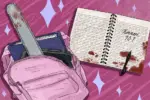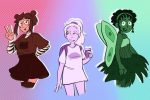Boy bands, fads, pop music and now, the VSCO girl. These are all hallmarks of teenage girl culture and have been for a long time now. Traditionally, society looks down on these things because they are deemed either tacky or unsophisticated. However, deeply rooted in these conditioned attitudes is both misogyny and ageism. Being a teenage girl is hard enough without the added stigma of society inherently deeming your interests and hobbies as bad. Although generational divides between younger and older people have always been evident, the rise of social media giant TikTok and the continued success of Instagram and YouTube with the younger market has only further polarized Boomers and Zoomers. The most current trend of mimicking “VSCO girls” is just the latest example of teen girl culture and its patronization.
The continual expansion of the internet and social media has allowed for plenty of subcultures and sects of popular culture to develop. With so many options for social analysis, why focus my efforts on explaining the validity of the teenage girl specifically? The simple answer is that they are one of the subcultures with the most longevity. Starting in the 1950s, as pop culture started to take form in households across America, teenage girls began to establish their own kind of cultural niche.
The Beatles, The Backstreet Boys, One Direction and now BTS, just to name a few, captured both the imaginations and hearts of countless girls. If their sheer numbers are not enough to prove their validity, then what will be enough? Despite their continuous presence in popular culture, teenage girls’ interests are habitually either overlooked or deemed distasteful by society. Over the years, this niche has grown from following boy bands and fashion to writing fanfiction and most recently, the advent of the VSCO girl.
The VSCO girl trend has been making the rounds on social media since around late August. While it is difficult to trace the trend’s exact origins, there has been an ever-increasing swell of posts referencing VSCO girls. So, what exactly is a VSCO girl? In the simplest terms, she is a stereotype of the current teenage girl. She wears oversized T-shirts and an armful of scrunchies with a Hydro Flask water bottle and metal straw in hand — bonus points if she has a puka shell necklace, Burt’s Bees chapstick or a penny board. Additionally, its name comes from popular photo editing and posting app VSCO. VSCO is similar to Instagram, but it does not have “likes.” If you somehow still haven’t stumbled across this craze on social media, this video is a nice introduction.
Between the “Sksksksk” hisses and abundance of “And I oop—” exclamations, there is a caricature of the modern teen — but a caricature that has been molded by the teenage girl herself. It is a joke that teens everywhere are in on, because they have all seen a real-life, authentic, in the flesh VSCO girl at some point or another. Again, internet culture has provided a platform for teenage girls to connect with each other like never before. As previously mentioned, the teen girl identity in pop culture has revolved around passion, whether it be for boy bands, fashion or whatever else. TikTok and Instagram have made it easier than ever to share their passions. Many of these TikToks feature a person dressed in a baggy T-shirt and scrunchies offering the viewer all their possessions in order to also make them a VSCO girl. This trend within a trend only advances this idea of interconnectedness.
Additionally, we have already seen major cultural impact from VSCO girls. I would bet that you saw at least a dozen people dressed up with scrunchies and Hydro Flasks this past Halloween. Similar to the fads of the past, teenage girls know how to mobilize and make something, or someone, a mainstream artifact overnight. A prime example of this is Justin Bieber’s first YouTube video of him singing, which now has over 57 million views. That video was uploaded and gained tremendous traction, which eventually caused him to be discovered by Usher. Although popularizing a singer and spreading a TikTok meme are two very different things, they both demonstrate the cultural power of teenage girls. Their capability to band together behind an idea, person or thing is palpable and this is constantly proven by cultural sensations like VSCO girls.
However, like any popular trend, there is also room for fads like these to have their fair share of negative impact. Like this New York Times article by Jackie Ashton suggests, the pressure to conform is also reinforced through ideal and widespread images like the VSCO girl. Yes, the trend is parody, but it is still riffing off of very real standards of teenage girls. Hydro Flasks and saving the turtles are just as real as the VSCO girl herself. Normal high school pressures to fit in can be heightened by a checklist like this. The standardization of belongings and appearances can prove to be detrimental to teens’ mental health. It is important to keep in mind that VSCO girls are a stereotype. There is no need to prove yourself and your dedication to the aesthetic.
can we stop making fun of girls for trying to figure themselves out like “ugh vsco girls” “ugh edgy girls” “ugh art hoe” .. they’re literally kids who like a certain style get a fuckin hobby
— aidan (@AIDAN) November 22, 2019
In a way, the VSCO girl is a kind of a reclaiming of identity. The teenage girl is used to being put down in whatever subtle ways day-to-day, but this exaggerated persona is her own creation. Real life girls who would probably fall into some category of the big-shirt-wearing, Hydro Flask-carrying character are creating their own content under the name of this new self. While the whole VSCO girl trope is meant to be a kind of joke, it is empowering because it is a celebration and acknowledgment of this teenage girl culture that has always been humming under the nose of everyone else. The teenage girl has brought us new fads, heartthrobs, music and so much more. It is time that we stop shaming them and their interests for being enthusiastic and passionate.
















